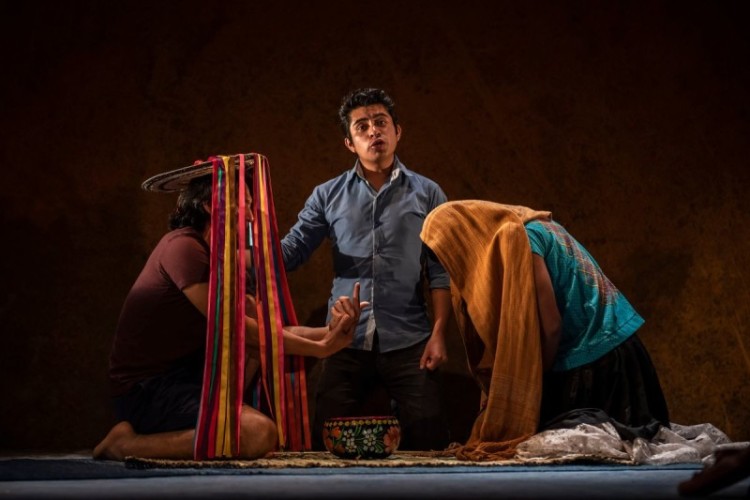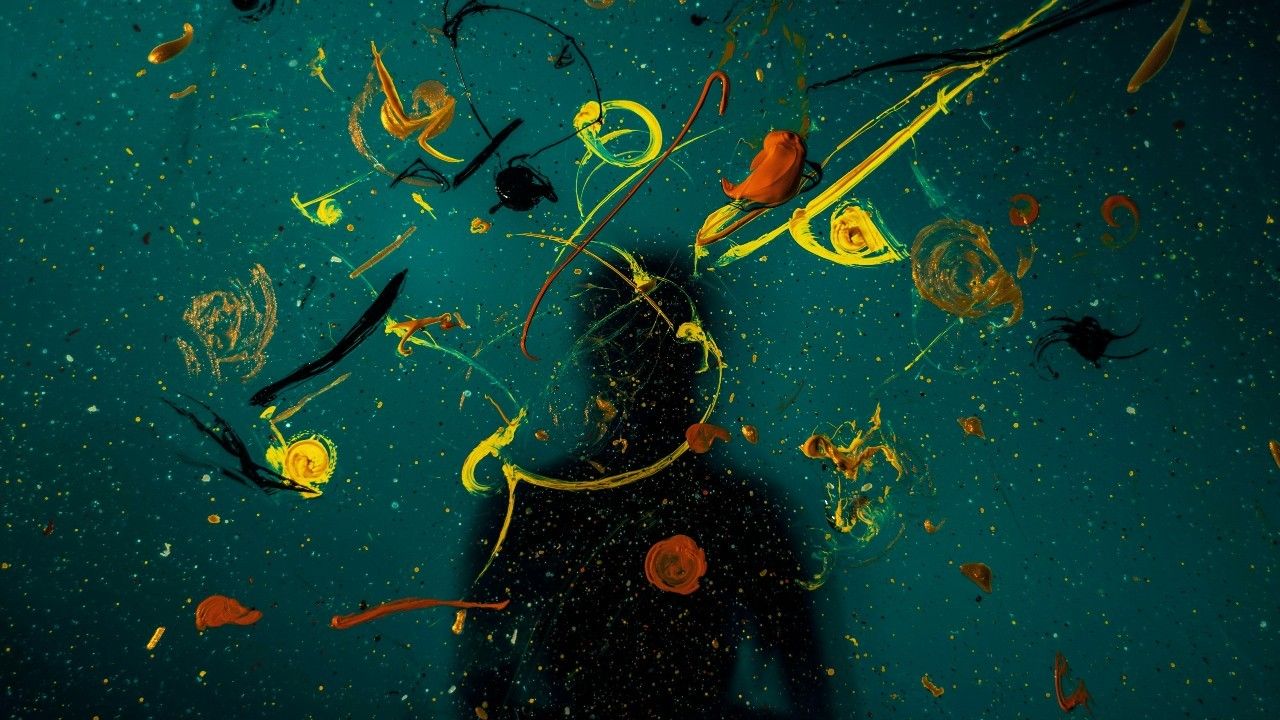This week kicked off the Under the Radar Festival, an international experimental theater festival produced by the Public Theater. Now in its 16th year, the Under the Radar Festival serves up innovative work by artists from around the world for New Yorkers, as well as theater presenters in town for a major theater conference by the Association of Performing Arts Professionals (APAP), allowing experimental theater artists to have their work seen by a broad array of theater-goers and producers from around the world.
Extended Play’s Daniel Krane spoke with Mark Russell, the Director of the Under the Radar Festival and programmer of this festival’s diverse offerings, as well as Héctor Flores Komatsu, the director and writer of Andares, a theater piece created collaboratively by the Makuyeika Colectivo Teatral starring indigenous Mexican performers.
Under the Radar 2020 runs through January 19 at the Public Theater and affiliated theaters in New York City.
MARK RUSSELL: CELEBRATING A “ROARING” FESTIVAL
DANIEL KRANE: Could you tell me about what programming this festival looks like? I assume you must see hundreds of shows over the year.
MARK RUSSELL: I travel to far parts of the world and go to festivals where I can see a lot of things in a short amount of time. I have friends around the country and around the world now that tell me what they think would be right for Under the Radar. So I get lots of recommendations, which is great. It helps point me in the right direction. And we’ve got a great staff here at the Public that’s going out to see things as well, so we just keep our feelers out there all the time. And now we’ve been doing this thing with the Devised Theater Working Group, which is a working group, sort of like the Emerging Writers Group, but for devised artists or artists that wouldn’t necessarily call themselves theater artists. We show them the tools of making theater at the Public Theater and they do a work-in-progress show. That’s our Incoming! Series, which is a festival within the festival.
DANIEL: It seems to me like you have kind of two different communities that are converging on this festival. There are the artists who participate, some of whom now have done pieces in the festival for multiple years, and now there’s probably a steady audience of people who come to the festival year in and year out. What does that community look like to you? How much do you see building that community as part of the work that you’re doing in the festival?
MARK: Oh, a lot. I think we get to a different kind of community that’s not always going downtown, or you’ll find at the Bushwick Starr all the time. So I think there’s some hip folks that might wait until the Public does it so they know that it’s going to be interesting. And they can spend two weeks immersing themselves in experimental theater if you will. Then they know a lot and they’ll go back to seeing Broadway and wait for those artists to show up in Off-Broadway and Broadway and track their changes. We’re becoming more of a destination festival for a lot of international presenters and even people coming internationally just to see the festival. So, I’m always trying to diversify this festival as far as shaking it up geographically, and constantly monitoring what audience we’re bringing in. This year, for instance, we’re doing longer runs of shows, hoping more people, more New Yorkers, will discover them. Because right now, when you do five shows of something over one weekend, by the time they’re gone, that’s when people begin to hear about them. You go, “Oh we missed that!” So now I’m trying to stretch it out so that the word of mouth within New York City itself can take hold. What’s really great is when some of these artists are brought into the breath of New York. Like, “Okay, we know what that guy does, we’re interested in what that guy is doing. We saw Ahamefule Oluo last year, we’re excited to see him this year, I’m interested in where he’s going to go.” It becomes more of a name, more of something people are in dialogue with.
DANIEL: Could we talk about that dialogue for a second? One of the things I notice in your programming this year is that there are multiple shows that are really diving deep into dealing with Black liberation and there are also a few shows that you have engaging with neurodiversity and actors and performers with different kinds of disabilities. How do you think about the shows that you program in conversation with one another? Do you have any kind of conversations that you’re hoping people are going to have coming out of this festival in 2020?
MARK: Well, you know, festivals are celebrations. This is Mardi Gras for experimental theater. In some ways, I want people to come to this festival and see as many things as possible. It’s about the bumping up between each show that begins to make sense of the whole festival. Now, I don’t book by theme. I just try to feel what is right to come here. And what is the field saying? Artists don’t always say things that you think they will. You would expect us to have a lot of anti-Trump stuff. Well, we don’t. There are other parts the entertainment industry that are taking care of that. So what our artists are dealing with is something sort of deeper, underneath the skin of where America is at this moment, or where the world is at this moment. And that’s what I’m interested in. When I see my audience coming out and I talk to them there, between shows, I’m finding out more about the festival. It’s a journey that I’m on as well as the artists as well as the audience. Does that make sense?
DANIEL: Yeah. It sounds like those conversations are also part of making meaning of the pieces and the whole festival, too. They make sense together and the audience is a part of that.
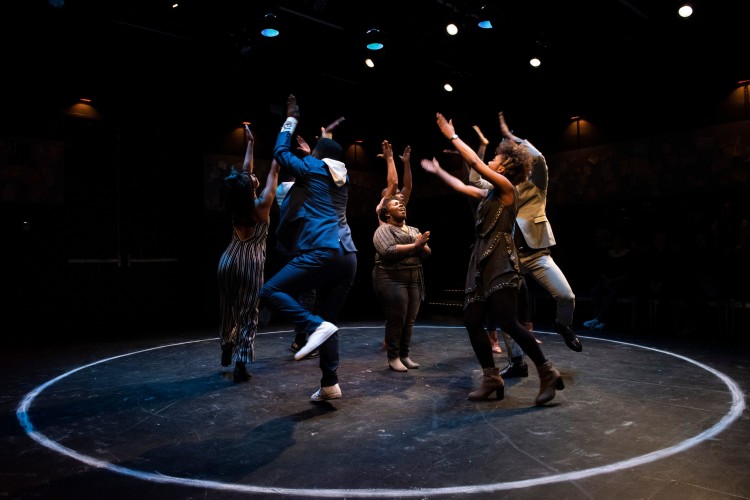
MARK: You know, the festival just before Trump’s inauguration was a lot about grieving. People needed to be together for that. And it formed a healing community around that work and going forward. This one, I don’t know what it’s going to say about now. But in some ways I think it’s a roaring festival.
DANIEL: Can you say more about that? What’s a roaring festival?
MARK: I think this is a festival, underneath all of this, is a little bit of rage. Where we are and where we’re going. This is a moment to prepare for activism.
DANIEL: And so these are pieces that—
MARK: These pieces will not necessarily direct that. They’re not going to say, “Oh, we’ve got to get together.” There’s a couple of them. But it’s the material that they’re mining, like What to Send Up When it Goes Down [by Aleshea Harris], which is an amazing piece. But it’s a ritual. She wrote it as a ritual about Black bodies being murdered. And she wrote it for a particular audience, and, of course, that theme, or that issue is rising, and I wanted to reflect the fact that, right now, some of the strongest writing and strongest theater in New York is coming from Black voices, of course. And women Black voices, or queer Black voices, are finally being heard, and they’re being heard in a different way than, say, they were in the 60’s, 70’s. The conversation is taking a step up. That’s one of the reasons we wanted to bring the Movement Theater Company and Aleshea’s piece here is that we think this piece will most likely tour more to different communities, to many other communities. And that’s a very important part of this. Because a lot of our work is like, “Why do theater now when you can do a podcast on your phone?”, you know? And reach a hell of a lot of more people. But the experience of theater is so particular, so sort of primal and special that it does things that you can’t get other places.
DANIEL: That was the thing that I experienced most powerfully at last year’s festival in the Rude Mechs’ piece, The Cold Record, and 50/50 Old School Animation. There was something so visceral and intimate at the same time about both of those pieces that I’m trying to replicate myself. It was really, really exciting.
MARK: Great. I love those pieces. I hope you get to see Back to Back. I mean I hope you get to see all of these things, it’s very hard, they’re all my children.
DANIEL: I was just about to ask you the awful question of if you have any shows to plug in particular.
MARK: Well, I’m very proud of this Back to Back piece, The Shadow Whose Prey the Hunter Becomes, which is done by people that are neurodiverse from Australia. And it’s a company that’s been together for 20 years. They’ve been here a couple of times. Their last piece here was Ganesh vs. The Third Reich, which was a huge monument within Under the Radar history. And this year we’ve been able to commission this piece as well, and put some money in — it has many commissioners, it’s a big piece — but the Public Theater joined in and put money into the process of making this piece. This is one of the first times it’s going to be seen outside of Australia. I’m really excited about it.
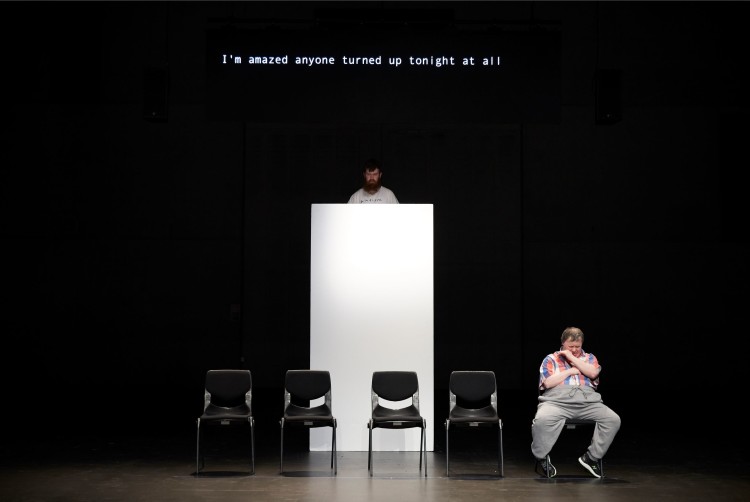
DANIEL: I’m the sibling of someone on the spectrum as well and so I’m very, very excited to see some work by actors on the spectrum this year. I think that’s really powerful that you’re doing that in your programming. I’ve heard Back to Back are amazing.
MARK: They are amazing. Somehow disability or different ability came up in many of the pieces we were beginning to bring here. You know Ryan Haddad, who was from our Devised Theater Working Group and is now a playwright, and he’s in The Politician and all this, he has a very beautiful cabaret piece called Falling for Make Believe, which I think is just gorgeous and actually one of the most direct experiences of what Ryan brings to the world. Then, we’re doing this Touretteshero piece — the company’s name is Touretteshero — it’s actually Jess Thom who’s the artistic leader of them. And, of course, she has Tourette’s and she has taken the challenge of doing Beckett’s Not I speech.
DANIEL: One of the most challenging pieces in the canon.
MARK: Exactly. We do it within a relaxed environment, which is something that’s been coming through England and Canada. They’re sort of available for everyone. Sometimes the lights will lift up a little so that you can see, you can move around. It is an accepting situation where the rigid constraints of theater watching are not necessarily enforced.
DANIEL: So there’s a more open audience, hopefully, for that.
MARK: If you are someone with Tourette’s and you get excited about something and you start saying your words or something of that sort, we put this in an environment where that’s all right. And there are actually places to go if you’re sort of triggered by something. We have a room where you can go to chill out. It’s going to be signed, which was a controversial thing for the Beckett estate to allow us to do because, of course, normally this is only supposed to be a mouth lit eight feet above the stage, doing this piece as fast as they can. And Touretteshero was able to get the permission of the estate to have it also signed at the same time. It’s major.
DANIEL: So it’s going to be a Not I like no one’s ever seen before.
MARK: Exactly. The piece is only twelve minutes, but then she comes down and talks to the audience about the process and shows us a short film of the process of making this piece. And, she’s an amazing activist for Tourette’s and neurodivergent people. My last one, if you have room.
DANIEL: Absolutely.
MARK: You know, people need to see Josh Fox. Josh Fox is known now as a documentary filmmaker, sort of our generation’s Michael Moore, perhaps. He did a piece called Gasland about fracking and environmental damage. Before he made those movies, he was a theater director in Manhattan. And, now he’s looking back, doing a sort of a Spalding Gray with media about his whole process of coming to where he is today politically, et cetera. Because once he started doing these environmental films, where they would light the faucets on in Flint, Michigan and the water actually burns, he began to get visits by people like the FBI.
DANIEL: Oh my god.
MARK: You realize how subversive this work is, how important it is. And I think he’s a major voice for what’s coming up and what’s going to go, what’s going on.
HÉCTOR FLORES KOMATSU: THE PERSONAL MEETS THE MYTHICAL IN ANDARES
DANIEL KRANE: For someone who hasn’t seen Andares, could you tell me what the piece is about and what questions you were setting out to explore when you started making it?
HÉCTOR FLORES KOREMATSU: I think it’s a question about origin. When I came back to Mexico after I graduated college in the States, where I grew up, I was hoping to find something that could help me understand myself better, understand the country where I came from better. And what’s closer to the roots than the indigenous people of Mexico who are continually marginalized and taken outside of the conversation and the narrative and the history? Part of Andares was making those voices of indigenous people the subject of this piece. At the same time, I wanted to make sure that it was going to be reflective of, not only this very particular world of indigenous communities, but of us all in Mexico and maybe even of human beings as a whole. We take it from the very cosmological, mythological parts of these three cultures: the Mayan culture, the Huichol culture, and the Zapotec culture. We begin to play with how each of these particular peoples imagine the birth of the universe and birth of who they are as a people. And then, little by little, it starts becoming a lot more personal about each of the actors on stage. We devised the piece collaboratively as a group. It was all built from personal anecdotes they were sharing and then, mixed in with those anecdotes, very ancient myths and stories, and trying to find a common ground between all of them.
DANIEL: Could you tell me about the process of meeting and finding these performers that you worked with? What did your devising process look like for this piece with the collective?
HÉCTOR: When I graduated college, there was this fellowship that came out by Julie Taymor called the Julie Taymor World Theater Fellowship. And it was for young directors to go out and explore the world and look outside the Western theater canon for inspiration and allow oneself to grow. Hopefully, that would turn into something that would translate into the stage. I applied for it, I got it, and I went straight to Mexico, not knowing what I was going to find. I just knew I had to travel and search and question myself, “Where do we all come from and where do we want to go? What’s our present time?” And so, after maybe ten months of traveling across the country, from the jungle of the south, all the way to the deserts and high mountains in the north, talking and meeting different people from indigenous communities, the most pressing thing to me was the incredible people and their everyday stories that I had met along the way. I thought it was very important, if we were going to delve into the issue of indigeneity and the original peoples of Mexico, that it had to come from their voice — that it couldn’t be me just sitting by myself in my studio writing a play about them. Rather, we had to come together and see what kind of connections would arise from that encounter. And so I invited four — well, actually, I invited eight artists, but only four of them were able to join me in an abandoned house in my hometown of Cuernavaca. We lived together for about a month and then, little by little, by sharing bits of ourselves and where we came from, we started to find this underlying tejido — this textile, I’d say — in which each of their stories intervened with the one of the other. They found much in common that they wouldn’t have found unless they would have met. As a director, I would look at everything that was being shared and then I would then weave the story in the narrative that occurs within Andares from beginning to end.
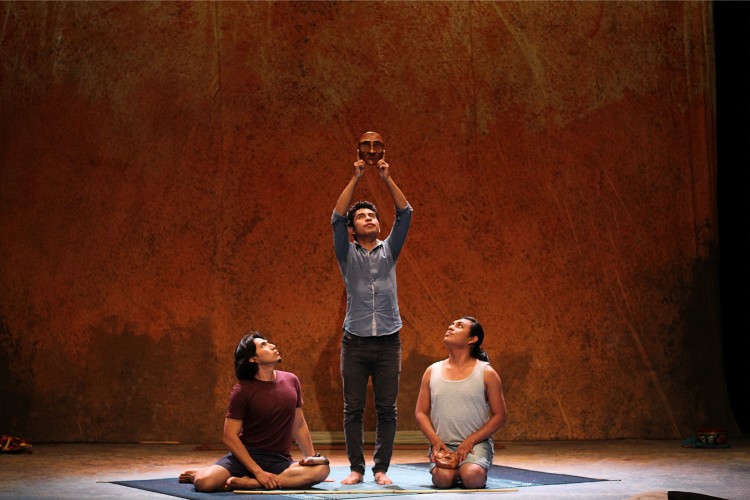
DANIEL: Could you tell me about what that sharing looked like where you guys came together? What surprised you during that process?
HÉCTOR: I think what was surprising to me was seeing how quickly they were able to connect to each other’s stories while still maintaining their own individuality. Because, at the end of the day, we’re a collective, but we’re a collective of individuals and, I think, as individuals, we have our own force and our own essence. But when all of those come together, it becomes its own thing that is amazing in a very subtle and even unexplainable way. We began the process simply by telling a story, a made up story. Through that improvisation, certain images began to appear. One of those big images was the stag or the deer. And then I learned that this stag had a very big importance to each of their cultures, but also they as individuals connected with that image, because it meant something to them personally. And so I think the rest of the play developed from that central image of the stag.
DANIEL: It sounds like you’re working at kind of two different levels here. There are these big picture windows into different indigenous cultures in Mexico and also very personal stories of these performers and collaborators on stage, and that’s all blending together in the piece.
HÉCTOR: I think that’s one of the strengths of the piece. You get to meet these people at a very, very intimate level, and, at the same time, once you take a few steps back, you can see a whole mosaic of human experience. It’s very special to experience.
DANIEL: Could you tell me about what the touring process has been like for this piece? I know you guys have gone all over Mexico and also went to China and now you’re presenting it in the US. I’m curious about how performing it in these different environments has changed the piece.
HÉCTOR: It’s been a little over two years now that we’ve been performing. And I think the real joy about Andares is that, no matter where we’ve been, people are able to connect with the piece from very different spaces of understanding. In the beginning, when we were in our residency, we had these big artistic ideas and things that we wanted to share and say. Then, we went on tour to Oaxaca, which is in southern Mexico, to different communities: Zapotec communities in the valleys, in the mountains, the isthmus. Around that time was when the big earthquake of 2017 happened. And we were heading to one of the hometowns of one of the actors in Tehuantepec. Two days before we were supposed to arrive—we had our bus tickets and everything—the earthquake hit. The theater we were going to perform in in Tehuantepec had partially collapsed. So we couldn’t perform there anymore. The house of one of the actors had also partially collapsed.
DANIEL: Wow.
HÉCTOR: In a nearby town, maybe half the buildings were razed. And so we were suddenly faced with the question of, “What good is sharing all these big artistic and social ideas with people that have much more immediate needs that need taking care of than what you’re going to do with your work?” But we decided to go nonetheless. And we started performing the play in refugee camps around the area. And we realized suddenly that one of the greatest strengths was the human element. That people were able to connect with simple stories about motherhood, about wanting to prove yourself to your community, about needing to reach out to your ancestors or whatnot. Suddenly, all those big ideas went out the window, and the play became this very distilled and down to earth piece of theater. Having performed there and then a year later going around the world to China and having people react very similarly, but also from their own universe, is an incredible, incredible gift. Because we are sharing something that I know only us as a collective, us as a people, us as a nation of nations, can share with the rest of the world. And it has a value to other people, to other countries. Not from a curiosity perspective of, “Oh, that’s interesting how they do this in Mexico in this way and this traditional—.” No, no, no. But simply as, “What these people have been going through can teach us a lot about ourselves as human beings.” And that has happened in China, in the States. Maybe, who knows, it’ll happen in New York. So I think that is something that keeps enriching the piece. But at the same time it keeps grounding us.
DANIEL: There’s something very profound about experiencing a performance that still connects with someone even across a language barrier.
HÉCTOR: It’s crazy because it feels like such a present day experience. It feels very current. In villages or communities or small towns, it feels like maybe what Greek theater was like because, suddenly, the whole town is there and they start saying things. And they’re not used to seeing theater, so they don’t have these very, sometimes, stupid rules that we have where we can’t express ourselves as we’re seeing something. So they’re watching something and they’ll be saying, “Oh, you know, that’s interesting,” or “Oh, I don’t agree with that part. Why’s he saying that?” Out loud, for everybody there. There is this one particular moment where in the play there’s this muxe actress, which is a transgender individual traditional to the Zapotec culture in the south of Mexico. When we went to the Yucatan peninsula a little bit North, people were not aware of what this meant. Everybody joins the performance. You have grandmas, children, drunk people. So this drunk guy is watching the play and he says, “That’s not right! He’s wearing a dress.” And then another guy right next to him, this young guy, says, “But it’s freedom of expression, isn’t it?” And the drunk guy goes, “Oh yeah, yeah, that’s right, that’s right, that’s right.” And so suddenly you have these very democratic moments in the middle of the performance. It’s, at the end of the day, what theater is about. Coming together and sharing different perspectives and also creating a sense of unity and strength as a people.
“Andares” runs through January 19 at The Public Theater as part of The Public Theater’s 16th Annual Under the Radar Festival.
Author
-
Daniel Krane is a Brooklyn-based director, playwright, and arts journalist. He was the Civilians' Editorial and Social Media Intern for the 2019-2020 season. In addition to his work at the Civilians, he served as the Artistic Director at Princeton Summer Theater for two critically-acclaimed seasons, and has worked for the Public Theater's Public Works program and the Brooklyn Arts Exchange. His writing has been featured in American Theatre Magazine, Exeunt NYC, and Extended Play. He received his B.A. from Princeton University in 2018, where he studied Portuguese and Theater. DanielKrane.com
View all posts


